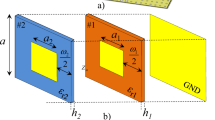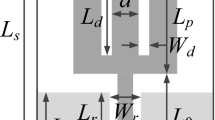Abstract
This paper proposes a design method for miniaturized planar bow-tie antennas typically used in Ground Penetrating Radar (GPR) based on topology optimization. To reduce the center operating frequency of the miniaturized antenna, a design strategy is given to determine a reasonable distribution of conductive material within a given domain. The skin-depth issue in the FEM-model is avoided by using the method of moments (MOM) and the degree of freedom is reduced by not discretizing the free-space box domain which can greatly improve the computational efficiency. Additionally, a novel method is proposed to model a non-conductive material by imposing infinite impedance through an exponential material interpolation function. Based on a series of numerical results, three technical problems in the electromagnetic structural topology optimization technique are identified, and a volume-preserving Heaviside density filter is introduced to guide the optimal result tending to a 0-1 differentiation. Numerical examples show that the proposed optimization method can reduce the center operating frequency of the antenna significantly, thus the effectiveness of our optimization method is verified.









Similar content being viewed by others
References
Anguera J et al (2001) Small and high-directivity-tie patch antenna based on the Sierpinski fractal. Microw Opt Technol Lett 31(3):239–241
Bendsøe MP (1989) Optimal shape design as a material distribution problem. Struct Optim 1(4):193–202
Best SR (2004) A discussion on the properties of electrically small self-resonant wire antennas. IEEE Trans Antennas Propag Mag 46(6):9–22
Bruns TE, Tortorelli DA (2001) Topology optimization of non-linear elastic structures and compliant mechanisms. Comput Methods Appl Mech Eng 190(26):3443–3459
Choo H, Ling H (2003) Design of broadband and dual-band microstrip antennas on a high-dielectric substrate using a genetic algorithm. IEE Proc Microw Antennas Propag 150(3):137–142
Diaz AR, Sigmund O (2010) A topology optimization method for design of negative permeability metamaterials. Struct Multidiscip Optim 41(2):163–177
Dühring MB, Jensen JS, Sigmund O (2008) Acoustic design by topology optimization. J Sound Vib 317(3):557–575
Erentok A, Sigmund O (2011) Topology optimization of subwavelengthantennas. IEEETransAntennas Propag 59(1):58–69
Harrington RF, Harrington JL (1996) Field computation by moment methods. Oxford University Press
Johnson JM, Rahmat-Samii Y (1997) Genetic algorithms and method of moments (GA/MoM): a novel integration for antenna design. In: Antennas and propagation society international symposium, 1997 digest. IEEE
Kramer BA et al. (2004) GPR implications of miniaturized antenna developments. In: Proceedings of the 10th international conference on ground penetrating radar, GPR 2004. IEEE
Kerkhoff AJ, Rogers RL, Ling H (2004) Design and analysis of planar monopole antennas using a genetic algorithm approach. IEEE Trans Antennas Propag 52(10):2709–2718
Mahmoud KR (2010) Design optimization of a bow-tie antenna for 2.45 GHz RFID readers using a hybrid BSO-NM algorithm. Prog Electromagn Res 100:105–117
Makarov S (2002) Antenna and EM modeling with MATLAB. Wiley-Interscience
Rao S, Wilton D, Glisson A (1982) Electromagnetic scattering by surfaces of arbitrary shape. IEEE Trans Antennas Propag 30(3):409–418
Svanberg K (1987) The method of moving asymptotes - a new method for structural optimization. Int J Numer Methods Eng 24(2):359–373
Xu S, Cai Y, Cheng G (2010) Volume preserving nonlinear density filter based on heaviside functions. Struct Multidiscip Optim 41(4):495–505
Zhou S, Li W, Li Q (2010) Sensitivity analysis for electromagnetic topology optimization problems. In: IOP conference series. Materials Science and Engineering, 2010. IOP Publishing
Acknowledgments
This work is supported by the National Basic Research Program of China (Grant No. 2011CB610304), the National Natural Science Foundation of China (Grant No. 11172052) and the Fundamental Research Funds for the Central Universities. These financial supports are gratefully acknowledged. The authors are grateful to Professor Liyong Tong of the University of Sydney for his kind help with the language and writing style of this paper.
Author information
Authors and Affiliations
Corresponding author
Rights and permissions
About this article
Cite this article
Liu, S., Wang, Q. & Gao, R. A topology optimization method for design of small GPR antennas. Struct Multidisc Optim 50, 1165–1174 (2014). https://doi.org/10.1007/s00158-014-1106-y
Received:
Revised:
Accepted:
Published:
Issue Date:
DOI: https://doi.org/10.1007/s00158-014-1106-y




